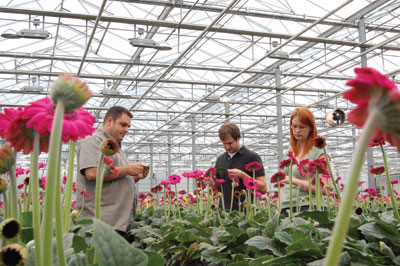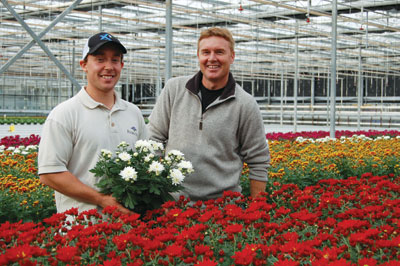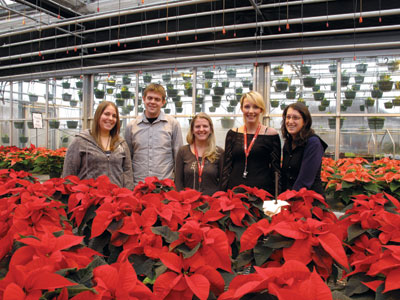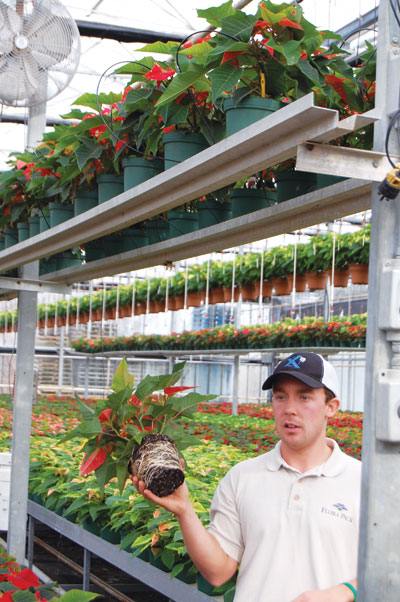
Features
Business
Grower Profiles
The ABCs of IPM
March 14, 2011 By Lisa Lunn Michelle Montgomery Dan Skinner Kathleen Stolfi and Joanna VanLuttikhuizen
A movement within the agricultural and horticultural communities is changing the way we approach environmental crop management.
A movement within the agricultural and horticultural communities is changing the way we approach environmental crop management. As more and more pesticides are pulled from the shelves, and as bylaws, legislation and codes continue to set restrictions based on environmental impact, growers are faced with finding alternatives for how they manage the growing environment.
 |
|
| David Neal, Adam Hendriksen and Kelly Saj. PHOTOS BY JOANNA VANLUTTIKHUIZEN Advertisement
|
Integrated Pest Management (IPM) considers all factors that affect a crop’s environment by taking a balanced approach to managing pest populations through adapted cultural practices, biological introductions, and limited chemical use to keep pest populations at manageable levels. This approach is quickly becoming the “how to” for producing quality ornamental crops with little environmental impact, and it is how future industry leaders are being educated in schools across Canada.
NC OFFERS HANDS-ON EXPERIENCE IN SCOUTING AND PEST MANAGEMENT
Among catalysts of this development is Niagara College’s Greenhouse Technician Program, located in Niagara-on-the-Lake, Ontario. Students and alumni of the program have quickly become leaders in the dissemination and implementation of IPM. Greenhouse Technician students take several courses in pest management and plant health, including an advanced course in greenhouse IPM and this gives them the hands-on experience of scouting, monitoring and managing pests found in a greenhouse environment. These are the growers of the future, the ones who will continue to move along with IPM and its benefits to the industry.
 |
|
| Brad and Ed Boekestyn, of Boekestyn Greenhouses |
Program coordinator Olga Piedrahita sees expanding opportunities for the alumni of the college; many of the graduates from the Greenhouse Technician Program are now involved in creating a true IPM system as growers, biological system specialists, or managers of their own greenhouses across Canada, the United States and Australia.
“If they have survived the ‘boot camp’ of the Greenhouse Technician Program,” says Piedrahita, “then can tackle just about any job.”
Adam Hendriksen was one of the first graduates of the program and speaks highly of it. “The future for new graduates is bright. Opportunities are everywhere because Niagara College (NC) has an excellent reputation. They give their students all the tools that are needed to succeed.”
SPREADING GOOD BUGS TO KILL THE BAD ONES
Hendriksen’s initial experience with IPM was spreading biological controls in an Ontario greenhouse with a summer job in high school. At that time, he got an apt explanation – you are spreading good bugs to kill the bad ones. “You could see them moving on the plant,” he recalls. “It was really interesting.”
 |
|
| Niagara College journalism students Michelle Montgomery, Dan Skinner, Joanna VanLuttikhuizen, Lisa Lunn and Kathleen Stolfi, authors of this feature.
|
That early experience piqued his interest. At Niagara College, he began to develop his foundation for IPM. It was in the Greenhouse IPM class where his skills really took off. “It was a practical experience class,” he explains. “We learned the basic skills for IPM from reading sticky cards, to plant inspection and more. As well, having Olga as an instructor really helped all the students because she is so well versed on the subject.”
Currently, Hendriksen is working as a biological systems specialist, and spends his day giving advice to growers who are learning how to use biological control in their operations. One of his greatest challenges in promoting IPM is finding enough time in the day.
“There aren’t enough hours in the week to meet with the many growers who are coming on board with IPM programs. An IPM program that integrates biological controls is designed for each specific greenhouse, the grower, and the crops they grow. Chemical control is showing deficiencies. Not only are fewer chemicals being registered, but insects are also becoming resistant.”
David Neal, another alumnus of Niagara College, also became familiar with IPM in its early stages. When he began college 10 years ago, the IPM concept was just getting rooted and it provided Neal a glimpse into the future of crop management. Having no greenhouse program at the time, he entered into the Horticulture Technician program where the broad-spectrum approach to education allowed him to better understand various industry concepts. Field-experienced teachers provided the industry knowledge and the college greenhouse allowed for hands-on education.
BIGGEST AREA OF GROWTH IS IN BEDDING PLANTS, ORNAMENTALS
Today, Neal works in southern Ontario and on the west coast of Canada, assisting growers with crop management practices and aiding in the successful implementation of IPM programs. He sees the future of the industry progressively incorporating more biologicals and true IPM programs as the main means of pest control in many crops. The largest area of growth seems to be within the ornamental and bedding plant industries, as these operations are only now beginning to adopt a true IPM approach that incorporates all possible means of pest management.
 |
|
| Brad Boekestyn checks root structure in poinsettia crop. PHOTO BY JOANNA VANLUTTIKHUIZEN |
Over at Boekestyn Greenhouses, recent NC grad Brad Boekestyn integrates IPM for their pot mum production. He became interested in IPM while at Niagara College. Having heard of it before, he was eager to learn more on the subject. The practical experience offered at the college is something he looks back on as invaluable because much of what he does professionally applies the material learned in classes to the conditions he finds at the greenhouse.
At Boekestyn’s, promoting a healthy work environment is important. With the use of biologicals, they can have people working at the same time as they are applying pest control. Although it costs more to run an IPM program, it is a necessary expense to avoid pesticide resistance in pests and to increase labour efficiencies.
Kelly Saj, yet another NC grad, also integrated her college training at her first job. When she was in school, the Greenhouse Technician program was very small, but Piedrahita greatly enriched her experience.
Saj’s education was certainly a stepping stone to her current career in IPM. She started in a garden centre and moved to a perennial nursery where she developed and implemented a successful IPM program. In this nursery, she also eliminated blanket spraying by starting a recording and scouting program. Saj saved the company money by utilizing chemicals only when needed; in other words, she didn’t waste chemicals or money.
COMBINING EDUCATION WITH WORK EXPERIENCE
When Saj was later hired as an IPM specialist for Cedarway Floral, she was again able to improve production simply by scouting regularly and cleaning up the crop. These efficiencies were achieved by using the skills she learned at Niagara College, as well as by incorporating her own experience.
Daniel Skinner is a second-year student at the college who has also just experienced the financial and environmental benefits of the IPM course. He was hired as a co-op student by Hendriks Greenhouses and has remained at his job while completing his Greenhouse Technician diploma. He is able to put skills into practice as he learns them.
He has found that having a firm grasp of biologicals has helped him to be more efficient and effective in his greenhouse job. When asked whether he thought having an IPM system is beneficial, he said that by knowing what kind of pests you have and where they are, you no longer waste materials and money to carpet spray your crop. Skinner believes that IPM is a more efficient system that does not cost extra money and reduces unnecessary pesticide use.
As positive as these stories may be, IPM is not always so successful.
Belal El-Hassan, the head grower at Hendriks Greenhouses and Skinner’s boss, offered the following example. His first experience with biologicals occurred when he was a tomato grower in Kuwait. El-Hassan had run into a problem with spider mites. He purchased some predatory mites and it was a total disaster; the predatory mites couldn’t handle the heat, behaved differently than expected and did not control the pests.
HELPING IMPROVE LABOUR EFFICIENCY
It wasn’t until he came to Ontario that he got his first positive exposure to IPM and biocontrols, and he hasn’t looked back since. He and his employer identified that this is the way of the future, so they made the commitment to IPM and biocontrols. Hendriks Greenhouses is an especially busy operation, thereby making the application of synthetic pesticides difficult. However, with IPM practices, they can manage labour efficiently without greenhouse entry restrictions due to pesticide use.
Looking into the future, IPM should continue to draw attention from the industry. New information on crop management and environmental controls is vital to ensure that Canada continues to lead in the development of strategies for ornamental IPM and biological systems.
Niagara College, through its Research Division, will continue to implement applied research projects that deal with IPM in greenhouses and nurseries. These projects not only enhance the students’ education, but also help industry partners with new products or new ways to use products, increasing success rates of IPM programs and biological integration.
As research, development and support for IPM techniques continue to flourish, Niagara College will continue to train future IPM practitioners who will go on to support the horticulture industry.
Lisa Lunn, Michelle Montgomery, Dan Skinner, Kathleen Stolfi and Joanna VanLuttikhuizen are students in the journalism program at Niagara College.
Print this page